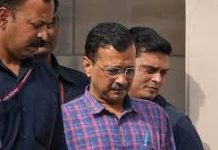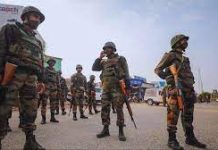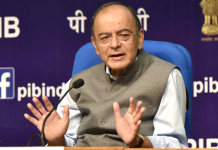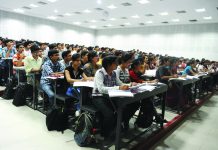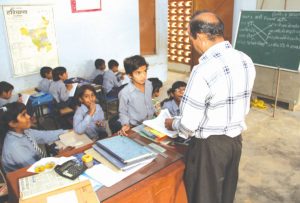 The Haryana State School Education Department statistics of 2018 shows that of the 1,28,732 sanctioned posts of teaching cadre, only 86,246 have been filled. As against 45,446 vacant posts, guest teachers fill 13,731 vacant posts. This is affecting enrolment of school children because as against 13,43,958 enrolments in 2012-13 in classes I to IV, they were 9,18,241 students enrolled in Haryana in 2017-18.
The Haryana State School Education Department statistics of 2018 shows that of the 1,28,732 sanctioned posts of teaching cadre, only 86,246 have been filled. As against 45,446 vacant posts, guest teachers fill 13,731 vacant posts. This is affecting enrolment of school children because as against 13,43,958 enrolments in 2012-13 in classes I to IV, they were 9,18,241 students enrolled in Haryana in 2017-18.
In neighbouring Punjab, more than 80 per cent academic posts are lying vacant in the State Council of Educational Research and Training (SCERT) and 17 District Institutes of Education and Training (DIETs) in Punjab. The academic staff shortage is a whopping 82 per cent (four out of five seats are vacant) in the district teacher education institutes across the state and 55 per cent in SCERT, according to an appraisal report prepared by the Educational Consultants of India Limited for the Union ministry of human resource development.
Against the academic staff of 425 needed in the 17 DIETs as per the government guidelines, the school education department has a sanctioned strength of 264. However, these district level institutes have academic staff of 76 and the remaining 349 posts are vacant.
Under the centrally sponsored Scheme of Restructuring and Reorganisation of Teacher Education, the central ministry has stipulated academic strength of 25 for each DIET to strengthen teacher education institutes.
Of the 22 districts, DIETs are currently functioning in 17. Though the department is still to sanction additional posts or even fill the existing ones, five new district teacher education institutes have been approved in Mohali, Tarn Taran, Fazilka, Barnala and Pathankot.
DIETs have been set up to undertake pre-service and in-service training of teachers, periodic school-based action research, assess pedagogical practices and coordinate with SCERT for teacher education and are critical to teacher training and, consequently, the quality of education in the state.
Similarly, SCERT, which was established in 1981 as the nodal agency for bringing qualitative improvement in school education, is required to have 45 academic posts, including subject, curriculum and training experts, as per norms, but the state government has sanctioned only 24, out of which, four are vacant. In Punjab, of total of 29,187 teachers in the state’s government secondary schools, 6,527 teachers (approximately 21 per cent) are untrained.
If we look at pan India figures, there are over two lakh teacher vacancies in secondary and higher secondary schools across States. Bihar and the newly formed Union Territory of Jammu & Kashmir have the highest number of teacher vacancies.
As per data presented by the Ministry of Human Resource Development (HRD) to the Lok Sabha, secondary and higher secondary schools in India have 2,13,608 vacant teacher posts (as of 2018-19). Bihar has 33,908 vacancies, followed by J&K (25,799), Arunachal Pradesh (21,393) and Madhya Pradesh (19,455). Uttar Pradesh has 16,087 vacancies.
Chhattisgarh, Rajasthan and Haryana are among the States with more than 10,000 vacant posts. Tamil Nadu and Kerala have over 4,000 vacancies each while Karnataka has 8,306. Delhi reported 6,832 vacancies. In fact, out of the total sanctioned teacher posts nationwide, 23 per cent are vacant.
Around 28 per cent of the faculty positions in the state universities and colleges across the country are lying vacant. Of the total 2,46,509 faculty positions, only 1,79,950 are currently filled and the remaining posts are vacant, according to information shared by the Union ministry of human resource development (MHRD) with the state governors last month. The process for recruitment to 7,959 of these teaching posts in government colleges in Bihar, Haryana, Jharkhand, Odisha, Uttarakhand and Chhattisgarh is currently underway.
The ministry has urged the governors of all the states to take up the matter with their respective state governments for filling vacant faculty positions in a time-bound manner. They have also been asked to direct the universities to prepare the roadmap and submit the same to their respective state governments. The vacancies have affected the quality of education in these institutions as several of them depend on temporary staff and guest faculty to impart education. Punjab, for instance, has only 391 regular teachers in government colleges against the sanctioned strength of 1,873 with part-time staff, guest faculty and retired teachers working on extension filling the gap.
Of the 292 state universities, 40, mostly in Rajasthan, Andhra Pradesh, Karnataka and Telangana, do not have full-time V-Cs. Besides requesting the governors to take it up with the state governments to fill the vacancies, the MHRD proposed that the University Grants Commission (UGC) should issue regulations prescribing 10 years of professorship, three years of administrative experience, research publications in global based journals not less than 30, guiding at least 10 PhDs and impeccable integrity as minimum qualifications for appointment of V-Cs in state universities.
The ministry has urged the governors of all the states to take up the matter with their respective state governments for filling vacant faculty positions in a time-bound manner. They have also been asked to direct the universities to prepare the roadmap and submit the same to their respective state governments.
Of the 292 state universities, 40, mostly in Rajasthan, Andhra Pradesh, Karnataka and Telangana, do not have full-time V-Cs. Besides requesting the governors to take it up with the state governments to fill the vacancies, the MHRD has proposed that the University Grants Commission (UGC) should issue regulations prescribing 10 years of professorship, three years of administrative experience, research publications in global based journals not less than 30, guiding at least 10 PhDs and impeccable integrity as minimum qualifications for appointment of V-Cs in state universities.
Education is in the concurrent list. The recruitment, service conditions and deployment of teachers come under the purview of the concerned States/UTs. The Ministry said that it has been requesting all the States and UTs to fill up the vacant posts and deploy them rationally.
It added that the Centre, through the Samagra Shiksha scheme, provides assistance to the States and UTs for deployment of additional teachers to maintain a pupil-teacher ratio per the prescribed norms, and for the induction and in-service training of teachers.
Interestingly, a World Bank study titled ‘Getting the right teachers into the right schools: managing India’s teacher workforce’, released in 2017, had revealed that those who have been employed as teachers often don’t go to schools but appoint proxies who may not even have the basic qualifications to teach. The World Bank Study report and the fact of vacant posts points to a stark reality-students at all level are bound to suffer be in school, college or university.
letters@tehelka.com


